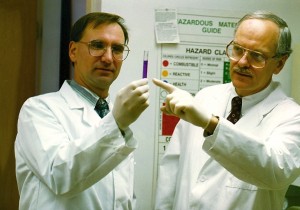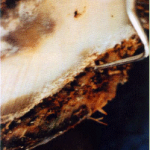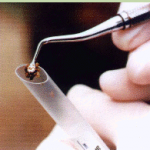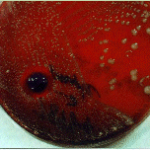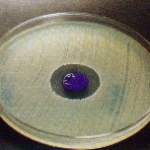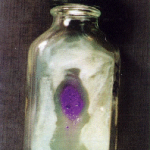By Dr. Richard Shakalis & Dr. John Pautienis
White line disease, seedy toe, hoof thrush, and many other hoof problems are the direct result of the domestication of the horse. The horse has been a roaming animal for 40 million years. In its natural habitat horses would not be in constant contact with manure and urine. Horses’ feet have no natural protection against the effects of ammonia for example. When you consider that the average horse produces 40 pounds of manure a day and gallons of urine, it is no wonder they have hoof problems.
What is White Line Disease ?
Researchers have spent a great deal of time trying to find the single organism that causes the destruction of hoof wall at the stratum medium, referred to as white line disease. The hope is that the discovery of the elusive bacteria or fungus will result in a definitive cure. Unfortunately, this approach is too simplistic for the complex biological event that is actually taking place. White line disease is caused by two different types of opportunistic microorganisms that exist in a symbiotic relationship. Together they produce enzymes and exotoxins that break down the protein and collagen of the hoof wall. This dynamic colony of microorganisms consists of at least one type of destructive bacteria and at least one fungus.
This information explains quite a bit. First, because it is not caused by a single organism, white line disease may appear different from horse to horse, depending on the particular makeup of the colony of microorganisms present. For example, if there is a very aggressive fungus present mixed in with a virulent bacterium, a fast-growing, hard-to-treat case will result. Conversely, if a slow-growing, less invasive fungus is paired with a more benign bacterium, this case can be treated more easily. There may be two or more destructive bacteria or fungi present in the same hoof. You can begin to understand that an infinite number of combinations can result. This also explains why a certain treatment may work effectively in one case and fail miserably on the next. To add another variable to the mix, these colonies are dynamic and grow faster when the environment is wet and warm, and slower when it is cold and dry.
In white line disease, bacteria and fungi live within the confines of the hoof wall in a symbiotic relationship. That is, they can live independently, but mutually benefit by each other’s presence. Each organism breaks down the hoof in a different manner while providing metabolites for the other. The fungi can be heterotrophs, obtaining their food from nonliving organic matter, or saprophytes, feeding as parasites on living hosts. They become deeply imbedded within the hoof wall and send out threadlike filaments called hyphae that absorb nutrients much like roots of a plant. The bacterium reproduces more quickly by dividing, but the fungus can produce spores that makes it harder to kill. Treating for bacteria or fungus alone is useless because when one is eliminated, the other will continue to grow unabated. You must control both simultaneously.
What Causes White Line Disease ?
These microorganisms are opportunistic in nature. That is, they ordinarily will not attack perfectly healthy hoof tissue but will enter into a small crack, nail hole, or fissure at the white line. These problems commonly occur at the stratum medium because this is where the horny laminae interlocks with the sensitive laminae. There is a rich blood supply here, and wherever blood is present in nature, there is a possibility of infection. Obviously a quick is an open invitation for infection. Another one is a case of laminitis that causes a split in the laminae. Even subclinical cases of laminitis, although not severe enough to cause lameness, could result in small tears at the stratum medium. Even bruising this area can lead to problems. Any trace of dried blood from the bruise makes a perfect nutrient for growth of these microorganisms. Be suspicious of any injury in the area of the white line, however subtle. It is best to treat white line disease aggressively and early.
Let’s examine a typical case of white line disease found in the Northeast (Figure 1). The colony of organisms found here are unique to this particular horse and may be entirely different from the ones you are fighting, but remember what all cases have in common: there will be at least one destructive bacteria along with at least one destructive fungus found in the culture.
We used sterile culture containers provided free of charge by a commercial medical laboratory to gather our hoof samples. We scooped out some soft, diseased hoof material with a clean instrument and gave the culture container to the laboratory (Figure 2). In our case we wanted to retest the effectiveness of an over-the-counter product specifically designed to treat white line disease, as well as identify all the bacteria and fungus present. The over-the-counter product we supplied to the laboratory technician was Sav-A-Hoof Gel by SBS Equine Products.
Note the probe is pushed up deep into the hoof wall before more sound hoof structures are felt. This soft area indicates diseased hoof material.
The laboratory technicians took the samples of diseased hoof wall and spread it on a blood agar plate and then placed it in an incubator. A mixed culture of organisms, just like what was found in the hoof, resulted (Figure 3). Each separate colony was then placed on their own agar plates, some in the presence of oxygen and some without, and the fungal samples were placed in small jars. This resulted in pure cultures for six different bacteria and a fungus, which were then identified by the technician.
Diseased hoof material was removed deep from within the hoof wall, along the leading edge of the infected area, and placed in sterile culture containers. Then these samples went to the laboratory technicians for analysis.
So what did we find from this mixed bag culture of micro-organisms? We ran the gamut, as one would expect, from very harmful to relatively benign bacteria, as well as a stubborn fungus in our sample. In every case, the over-the-counter product we tested – Sav-A-Hoof Gel – worked extremely well at killing both bacteria and fungus (Figures 4 & 5).
Note separate microorganism colonies growing across the blood agar culture plate after being removed from the incubator. This plate provides nutrients for the organisms to grow on. The anaerobes, including the fungus, were grown in oxygen-free jars along with a rich growth medium.
Of the six bacteria present, Providencia rettgeri, Klebsiella pneumoniae and Bacillus subtilis, although sometimes pathogenic in man, are not causing much destruction of hoof wall tissue here. They are simply taking advantage of a warm, dark environment to thrive in. The next grouping of bacteria, the Staphylococcus and Pseudomonas, are capable of producing enzymes destructive to the hoof wall. The Staphylococcus prefers blood and can thus elaborate many powerful toxins and enzymes through the blood.
By far the main destructive bacteria found was Clostridium difficiles. The Clostridia found here has some particularly nasty first cousins that are responsible for tetanus, botulism and gas gangrene. Clostridium is capable of producing spores and extra-cellular products such as powerful proteinases and collagenases, substances very destructive to the hoof wall. It is an anaerobe, which means it lives only when there is no oxygen present. It can produce a whole host of destructive enzymes such as fibrinolysins, collagenase, lecithinase and cytolysins. It is one nasty bacteria.
The bacteria are growing on the entire agar plate except in the darker, clear area surrounding the purple Sav-A-Hoof Gel sample. This area is bacteria free and represents the very effective kill zone. The bacteria are unable to grow or survive in this zone.
The special culture pictured in the jar isolated the fungus Geotrichum. This fungus is an aggressive saprophyte that grows vigorously on organic matter. It is commonly found in sewage treatment plants and is a spore former, which means it is difficult to eliminate. As shown in Figure 5, the Sav-A-Hoof Gel effectively killed this fungus, as well.
Note the fungus is unable to grow or survive within the clear area surrounding the Sav-A-Hoof Gel sample. Even with ideal growth conditions, with no oxygen and a rich growth medium, this area is fungus free and again represents the effective kill zone.
What are the best ways to treat and prevent White Line Disease ?
The best ways to treat white line disease is first to recognize it early and then treat it with a product that is a broad-spectrum bactericide as well as a fungicide. Deeply rooted infections like white line disease are impossible to kill with one application of a strong topical agent. Repeated use of these strong chemicals can be harmful to the surrounding healthy hoof tissue and slow the healing process. The SBS Researchers developed formulas that stop bacteria and fungi without harming sensitive surrounding tissue. The formulas are not caustic and can be used as often as necessary to keep infection under control and give healthy hoof tissue a chance to prosper.
Remember that dry, cool conditions are your ally and that warm, wet ones are your enemy. Because some of the different organisms present are capable of producing spores, choose products that are powerful and stay active for a long time. It takes time and patience to treat these infections once they gain a foothold. Even if you don’t kill all the organisms initially, repeated and consistent use with the right products may kill enough of them to slow the advancement of the disease to the point that it may grow out with successive trimmings.
Summary
The best ways to prevent hoof disease is to: (1) Seal out pathways of infection, which are cracks, nail holes and fissures. Use a quality hoof sealant that is made to web-seal these openings. (2) Frequent cleaning and trimming are the most important steps in dealing with infection. Encourage horse handlers or owners to be consistent with their hoof grooming. Remember, you cannot kill white line disease with any one treatment. Removing diseased tissue by the farrier and opening up the hoof to oxygen will give a head start to recovery. Improperly trimmed hoofs prevent oxygen from getting in crevices. (3) Use hoof conditioners that cure/or dry hard and build up protection. Hoof oils generally remain fluid (wet) and do not seal openings. They also offer less protection against hoof disease, and (4). Avoid using caustic chemicals that can harm healthy hoof tissue and slow the healing process.
The authors are hoof researchers and co-founders of SBS EQUINE, www.sbsequine.com, ph 239-354-3361.

